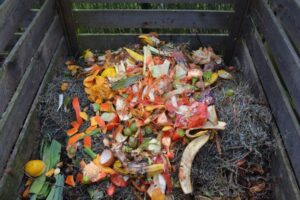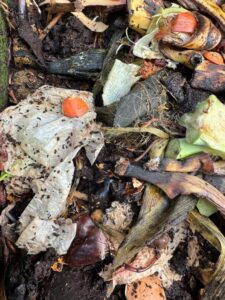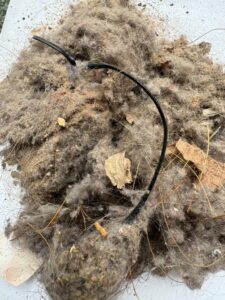
Recycling food and gardening organics study
Compiled by Karen Smith
Among the global targets set at the 2022 UN Biodiversity Conference, COP 15, in Montreal was an agreement to cut global food waste in half, and significantly reduce over-consumption and waste generation, and reduce by half, both excess nutrients and the overall risk posed by pesticides and highly hazardous chemicals.
With this in mind, the NSW Government is committed to net zero emissions of organics waste in landfill by 2030, halving organics waste to landfill by 2030 and recovering 80% of all waste by 2030. Methane production from food, garden and textile waste accounts for 3.1 million tonnes of carbon dioxide equivalent (CO2-e) generated each year from landfills in NSW, accounting for 56%of the total waste emissions from landfill. Collected at the kerbside and processed into compost or used to generate energy, food and garden waste is a valuable resource. Composted organics reduce emissions and return carbon to soils.

The discovery of asbestos contaminated mulch in NSW highlighted problems associated with recycled materials. It is generally accepted that recycling and developing circular economies, where materials are continually reused, is the only sustainable way forward. Food organics and garden organics (FOGO) regularly collected from kerb side bins are a valuable resource when composted, if they do not contain any nasty contaminants.
The NSW Environment Protection Authority conducted a study known as ‘What’s the go with FOGO’ from 2019 to 2021. They analysed composts prepared from these collections and measured over 260 parameters, being a much more extensive examination than normal national or international testing. The study was to ensure regulatory standards are appropriate and support the safe use of organics.
From the report, the food waste was generally high in nutrients such as nitrogen, potassium and phosphorous which are essential for healthy plant growth. The plant nutrient nitrogen was higher in FOGO than just garden organics (GO) compost. This was expected as kitchen and food wastes have a higher concentration of nitrogen than garden waste. Output from rapid dehydration food waste units were tested by the EPA and had the highest nitrogen concentrations as well as the highest salt content, which limits their application conditions.
Rapidly decomposed or dehydrated food waste is not compost. It is either partially decomposed or has simply been dehydrated. Re-wetting this output will restart the usual decomposition process that occurs with all organic waste and can generate offensive odours. Re-wetting will also encourage the growth of microorganisms that may remain viable in the output after the process is completed. When applied to land, this waste can also encourage organisms in the soil, including pathogens, to multiply.
All the recovered organics sampled were moderately to extremely saline, which will increase salts in the soils to which they are applied and may limit plant growth. The source of salt in the samples is predominantly from food waste and must be considered to guide appropriate use of recovered organics.
Metals were commonly detected in all FOGO and GO composts, but at levels that were below concentrations for the upper limits recommended under the voluntary Australian industry standard for composts, soil conditioners and mulches (AS 4454), and the British Standards Institution’s Publicly Available Specification 100 for compost (PAS 100).

From a suite of 93 pesticides tested, none were detected in the output from rapid dehydration units and six were detected infrequently in FOGO and GO composts. These were the organo-chloride pesticides (OCPs) chlordane, dieldrin and DDT, and the herbicides glyphosate,2-methyl-4-chlorophenoxyacetic acid (MCPA) and clopyralid. Some OCPs were above the industry Australian Standard AS4454 for composts, soil conditioners and mulches.
The study found that both FOGO and GO composts contained several chemical contaminants that are not currently regulated in NSW or most other Australian jurisdictions. These include perfluoroalkyl and polyfluoroalkyl substances (PFAS) and polybrominated diphenyl ethers (PBDE), chemicals which are probably due to ‘organically derived’ materials being innocently placed in FOGO and GO kerbside bins. The potential sources of PFAS are fibre-based food contact materials, such as baking papers, paper bags and wrappers for food, beverage cups, coffee filters, and paper tableware such as serviettes. The most likely sources of PBDEs are house dust derived from furniture, textiles and electric devices, and engineered timber mistaken for wood waste.
Microbiological findings included the frequent detection of viruses and eggs of parasitic worms (Helminths) in FOGO and GO composts and, less frequently, spore-forming bacteria. It is unclear whether the detected pathogens have survived the pasteurisation process or whether they are introduced at a later stage of composting. Helminths are soil transmitted and infect the gastro-intestinal tract.
The success of these recycling programs will rely on educating the public about what to place in the kerbside collection bins. The aim is that feedstocks for composting are as contaminant-free as possible from the point of collection, from both domestic and commercial sources. Verifying pasteurisation procedures will help show if pathogens are inactivated during pasteurisation and if they are accidentally being added at a later stage of the composting process. Good hygiene practices when handling composts will minimise health risks from pathogens.
The EPA is committed to maintaining a learning mind set, and to listening and actively engaging with people to understand the issues affecting them. They will continue to consult with the industry, councils, businesses and the community to ensure that the recovery of valuable food sources is sustainable. You can read the complete report at https://www.epa.nsw.gov.au/your-environment/recycling-and-reuse/business-government-recycling/food-organics-and-garden-organics/research-on-fogo
